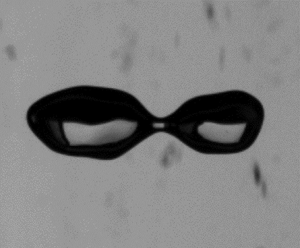Published online by Cambridge University Press: 27 August 2021

We study experimentally the behaviour of a bubble injected into a horizontal liquid solid-body rotating flow, in a range of rotational velocities where the bubble is close to the axis of rotation. We first study the stretching of the bubble as a function of its size and of the rotation of the cell. We show that the bubble aspect ratio can be predicted as a function of the bubble Weber number by the model of Rosenthal (J. Fluid Mech., vol. 12, 1962, 358–366) provided an appropriate correction due to the impact of buoyancy is included. We next deduce the drag and lift coefficients from the mean bubble position. For large bubbles straddling the axis of rotation, we show that the drag coefficient  $C_D$ is solely dependent on the Rossby number
$C_D$ is solely dependent on the Rossby number  $Ro$, with
$Ro$, with  $C_D \approx 1.5/Ro$. In the same limit of large bubbles, we show that the lift coefficient
$C_D \approx 1.5/Ro$. In the same limit of large bubbles, we show that the lift coefficient  $C_L$ is controlled by the shear Reynolds number
$C_L$ is controlled by the shear Reynolds number  $Re_{shear}$ at the scale of the bubble. For
$Re_{shear}$ at the scale of the bubble. For  $Re_{shear}$ larger than 3000 we observe a sharp transition, wherein large fluctuations in the bubble aspect ratio and mean position occur, and can lead to the break-up of the bubble. We interpret this regime as a resonance between the periodic forcing of the rotating cell and the eigenmodes of the stretched bubble.
$Re_{shear}$ larger than 3000 we observe a sharp transition, wherein large fluctuations in the bubble aspect ratio and mean position occur, and can lead to the break-up of the bubble. We interpret this regime as a resonance between the periodic forcing of the rotating cell and the eigenmodes of the stretched bubble.